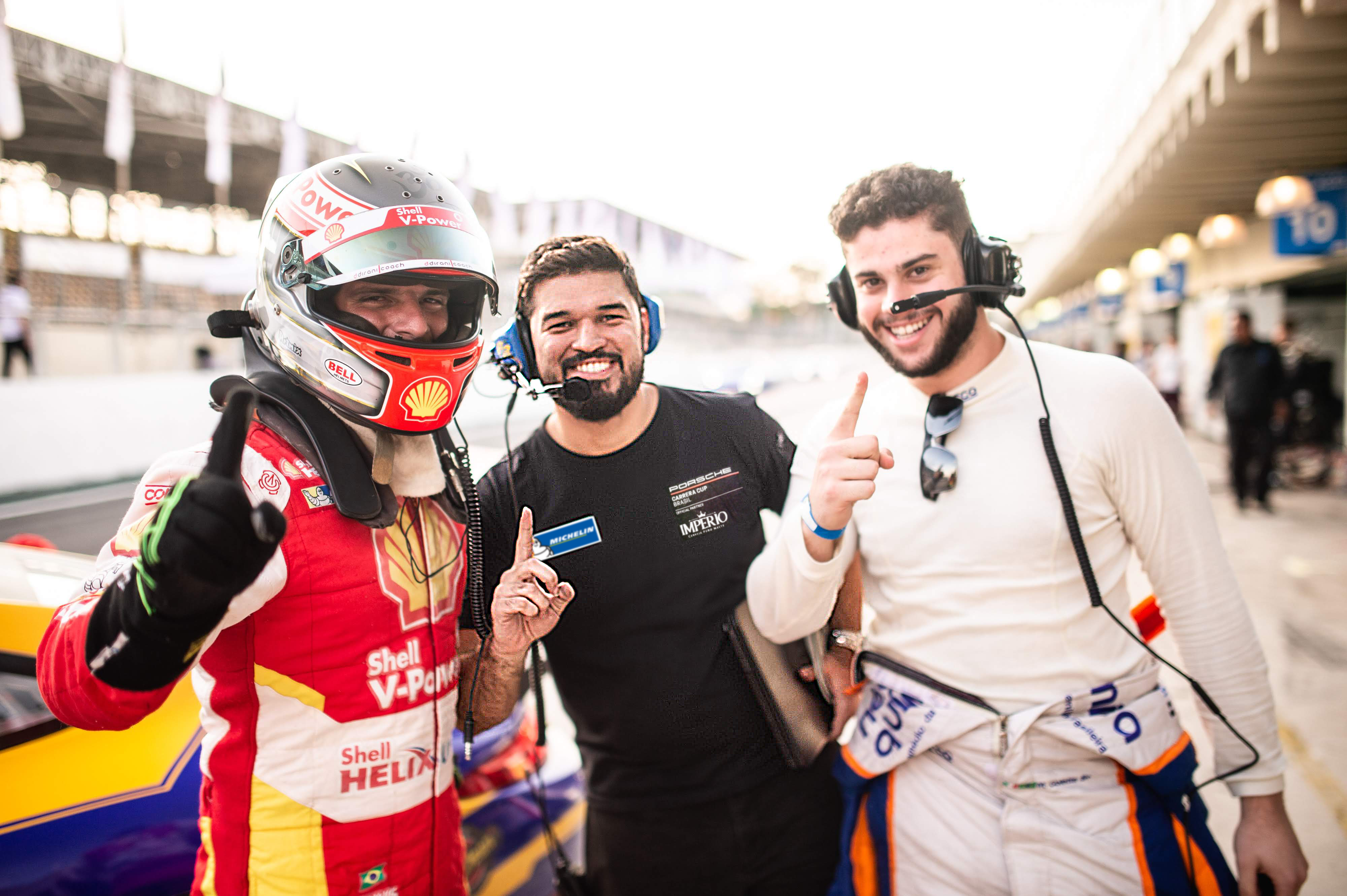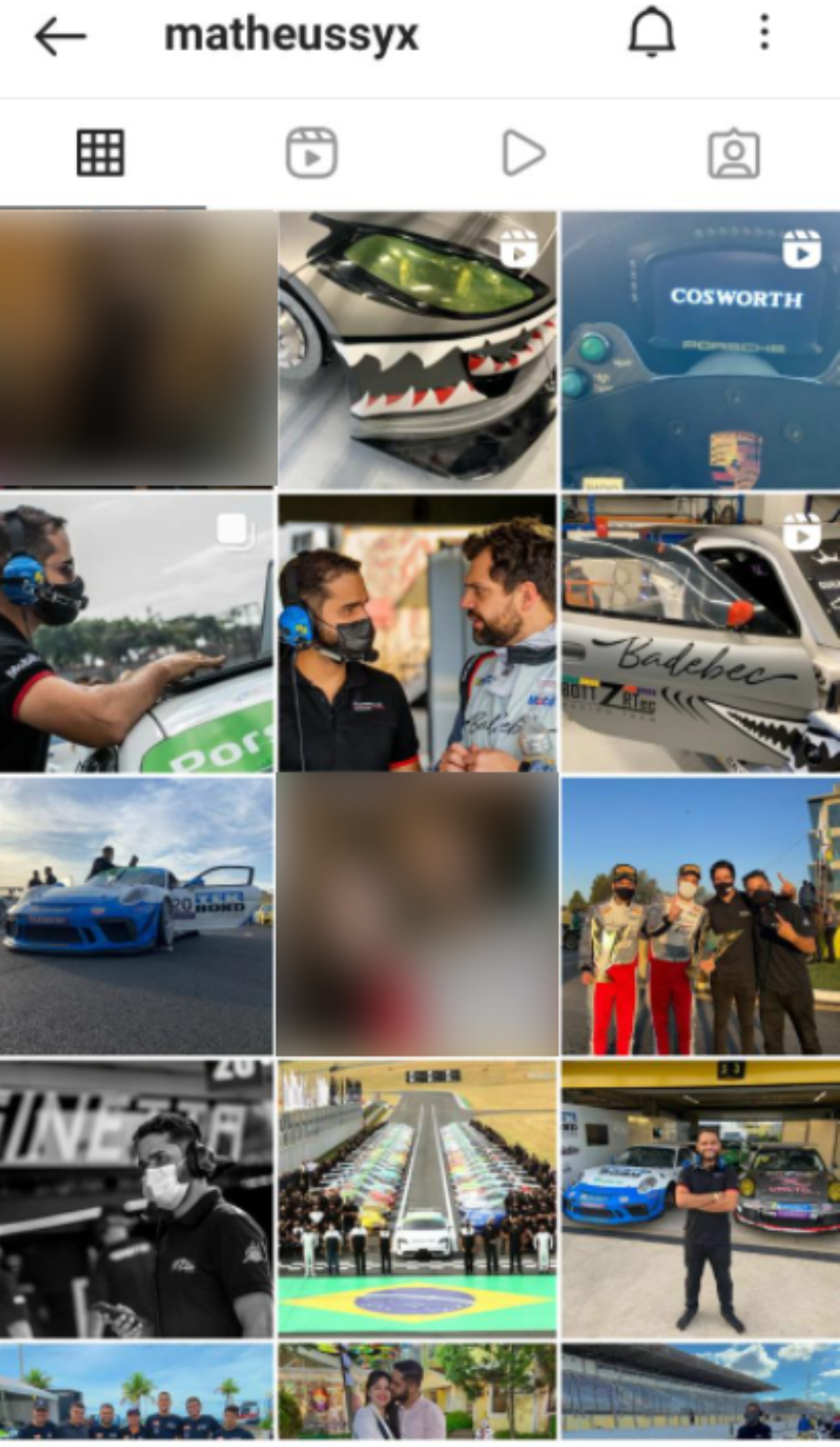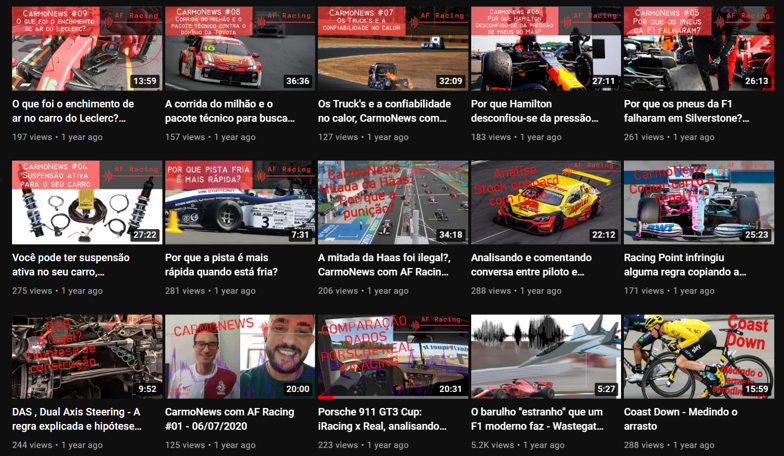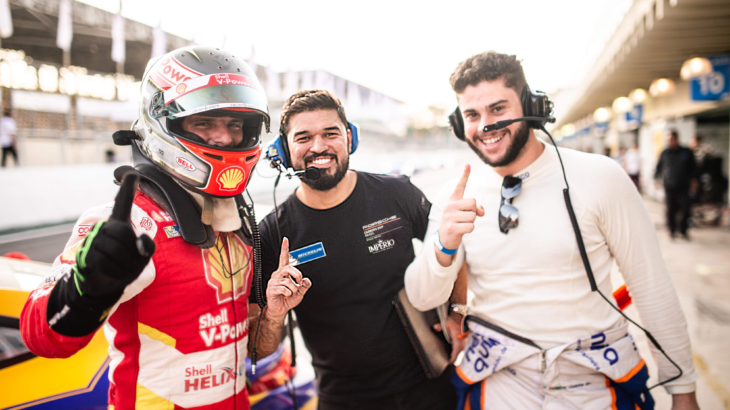
Photo: Porsche Cup Brasil
On march 24, 2015, I got an email that would change my career as a motorsport engineer! It read:
“Dear Rodrigo
I saw your website and enjoyed your work a lot. I am a racing driver and manager of a small team racing in Lotus Cup Europe, and we would like to know if you want to do some engineering/data analysis work with our drivers. We will take care of your expenses and pay you a daily fee for your work on the track with us. Would you be interested in that?
Kind regards,
Jonathan Walker”
Jon didn’t know it, but at that time, I would’ve accepted to work for his team for free. I even had offered to do unpaid work for many teams, as I was trying to get experience, but until then, none had accepted (many didn’t even reply).
And there it was, the opportunity I was looking for, for the past six months. I was having a year abroad in England, and trying as hard as I could, to build a career in racing.
Before going to England I had already done an engineering internship, working with race cars design, but designing was a totally different experience than trackside work, and I wanted to have that experience.
Jon’s invitation wasn’t a coincidence. I had spent the last eight months building my technical knowledge and developing a manner to showcase this knowledge. The invitation was the sprouting of a seed I had planted when I was still in Brazil, where I was born and raised.
And all of that started with a change in mindset.
Some bad news…
Coventry University, where I studied during my year abroad, offered a career support service, where human resources professionals helped the students to boost their CVs and get prepared for interviews and selection processes in general. The guys from that office were super helpful, but the first time I went there, I didn’t get good news.
“Here in the UK”, said the career consultant that helped me, “the companies pay a large sum to the government in order to get a work visa for people from outside the EU. And they see internships and placements as an investment, many interns are hired by the same company after they graduate. Because of that, it’s really hard for you as an international student to get a formal placement here, since it will be an investment that will have a higher price in the future.”
It was a hard truth to deal with. I was kinda angry with the whole visa situation, but I realized it was a circumstance that was out of my control. And that’s why I decided to turn my attention to what I could control.
The turning point…
When I left Brazil, I already knew it would be hard to compete for jobs since I had studied in a Brazilian university, and I knew the European universities were much better. That’s why I decided to identify manners to set myself apart among the engineering students in Europe. And for that, I decided to focus on the value I could offer. That was the turning point.
I asked myself: “what can I offer to whoever hires me, that they can’t get by themselves?” This question is hard to answer when you don’t have a lot of experience. But it shed light on a very important point: in any big team in any big series, I wouldn’t be of any use at that point.
Think about it, if a race team is at the top of the greatest series in the world, they probably already have a really good and experienced engineering team, and hence, they won’t miss the skills of an engineering student who is trying to acquire experience to start his career. But that didn’t mean there weren’t opportunities for me.
If I hadn’t realized this last point in time, I would probably be much further behind on my career path right now. The fact is, there is a plethora of hidden opportunities waiting to be discovered. They existed when I started, they exist today, and they will probably exist as long as racing itself exists. And I’m gonna tell you what these opportunities are right now.
The mistake I made too
Answer without thinking too much about it: where there are work opportunities in racing? Chances are you thought something like Formula 1 teams, IndyCar teams, DTM, World Endurance Championship teams, and so on. This is a mistake I made too.
It’s okay to think of these categories when you think about working with racing. You turn on the TV and they are on the sports news show. Your social media feeds are filled with memes and info about these categories.
Having the world’s most famous categories in mind when thinking about career opportunities isn’t a problem, the problem is thinking that these are the only opportunities. Many people say they are afraid to invest in a career in racing because the lack of opportunities. But the majority of them believe that there are opportunities only in the top tier categories in the world.
How do you think the people working in these categories got there? By indication from family members? Nothing could be further from the truth. Professional racing is a too demanding environment to allow for incompetent people.
THE HIDDEN OPPORTUNITIES TO START A CAREER AS A MOTORSPORT ENGINEER
If you really wanna make a career in motorsports, you need to face your journey as a climb. And nobody starts a climb from the top. You need to get to know motorsports beyond TV. Here are a few examples of where you might look for opportunities when you are starting out.
- Amateur categories
The best way to teach a kid to swim isn’t by throwing the poor thing on a furious sea. In top-tier categories, people expect you to be ready and have all the knowledge and experience to perform the work as quickly and effectively as possible. Hence, they are not the ideal environment to start. Thus, you should look for opportunities in smaller and amateur categories, such as club racing, local championship series and so on. - Racing parts manufacturers
Here most of the technical skills you will learn probably won’t be transferable to trackside work, but you still get to learn the work pace and soft skills such working under extreme pressure with super tight deadlines on these environments. - Motorsport software companies
This is an opportunity where you can learn simulation skills which are quite useful for the work in racing teams, and therefore are easily transferable. The best part is that you can try to get an agreement for remote work. A quick search on Google for “Motorsport Simulation Software” shows multiple motorsport software development companies where you can look for opportunities:
 Google search results for “Motorsport Simulation Software”.
Google search results for “Motorsport Simulation Software”. - Motorsport consulting companies
Again, here you can learn many technical skills transferable to the work with a racing team, and you can work remotely. Have you tried googling “Motorsport Consulting”? Let me show you (pro tip – there’s much more beyond the first page):
 Google search results for “Motorsport Consulting”.
Google search results for “Motorsport Consulting”. - Sim racing teams
With the development of sim racing software and PC hardware, sim racing is getting professional, with many teams arising as a result. This is a great opportunity for you to learn data analysis and performance engineering, both fundamental work for racing teams. Many simulators allow the creation of data files compatible with real world motorsport data analysis software, such as MoTeC i2 Pro. Be careful not to confuse it with work in a real world race team , the demand and pressure on the real environment is much bigger.
Notice that some of these opportunities solve a problem many people have to face, including me: there’s no racing where they live. I came from a town where the nearest race track having any professional racing is at least 2200 km away. If that’s your case, the most obvious option is moving from there. But if that’s not possible for you for whatever reason, you can resort to the remote work options, such as the last three I presented here.
Eventually, you will have enough experience to have a trackside work as a freelancer, and you will be able to travel to attend race and test events, while getting to live wherever you like.
Are you enjoying this post? Then subscribe to Racing Car Dynamics’ email newsletter, so that you won’t miss a single post!
 KEEP UP TO DATE
KEEP UP TO DATE
5 STEPS TO BUILD A CAREER AS A MOTORSPORT ENGINEER
Until now, I’ve shown you that there are many possible paths for you to start your career as a motorsport engineer. Now I will show you how to create opportunities for you while delivering tons of value to whoever hires you.
Here are the five steps to build your career in racing! Before I begin, let me clarify one thing: even though it’s only five steps, it doesn’t mean that it’s an easy plan! You will have a lot of work to do, and the results will take some time to come. But in the end, you decide if working with racing is a dream worth living or not. Here are the steps:
- Identify the Skills You Need to Learn and Learn Them
In order to identify the required skills, you can study job posts related to motorsport engineering, but also talk to people that already work on that area. In step 4, I’ll show you how to boost your network and create relationships with professionals you find interesting. - Showcase What You Learned (Create a Digital Presence)
Remember when I said I planted a seed when I was still in Brazil, before going to England, and that the seed sprouted eight months later, resulting in a job offer? Well, this was the seed:
…
I mean this. The one you’re reading right now. Racing Car Dynamics! This website was created when I was still a student, to showcase what I was learning at the time. Not everybody knows that, but I created RCD to boost my chances of making a career in racing. Here I wrote multiple articles about motorsport engineering, showcasing that I had what it took to do trackside work.
Today, with an active career in racing, I have a lot less time to post new content here. Yet, this seed fruits up to today. Already in 2021, I got an invitation for a gig that came from the content on the Racing Car Dynamics’ Instagram @racingcardynamics.
The best part is, your digital presence doesn’t need to be a website. It’s much faster and easier to create a YouTube channel or an Instagram. As an example, I’ll leave the social media of two friends of mine (like me, they’re Brazilian, and their content is in Portuguese, sorry). The first is Matheus Syx’s Instagram, @matheussyx. Matheus is an engineer in Porsche Cup Brasil and Brazilian Endurance Championship.

Matheus Syx’s Instagram page (I blurred his personal photos)
The second is Felipe Faria’s YouTube Channel. Felipe is a Race Engineer in Stock Car Pro Series and in the Brazilian Endurance Championship.
Felipe Faria’s YouTube Channel
Obviously, there’s a limit to the size of the content you can post on YouTube and Instagram. For Youtube, you can create longer videos, but on Instagram, you should post content that is short and fast to consume. The ideal compromise is to combine all strategies (website, YouTube channel, and Instagram) to create content in multiple levels of depth, thus, reaching more people. - Gain Experience
- Networking
Speaking about that digital presence, why don’t you use it to invite motorsport professionals for interviews, and seize the opportunity to create a network and also identify new skills to learn?
Besides, by inviting people for interviews, you’re giving them a platform to showcase their work and talk about their professional environment. That means you’re giving them value, without asking anything in return. This will make them more likely to help you, in case you need.
And that’s not something I made up, there are actual studies in psychology that show that people are much more likely to help people that helped them before, without asking anything in return. If you don’t believe me, look for Robert B. Cialdini’s book, Influence : The Psychology of Persuasion, and you’ll see the data.
Naturally, don’t invite people to talk, thinking of the opportunities they can get you. Be genuine and try to create a friendship with your invitees. Networking is about creating relations, not exploring people.
In this step, it’s super important that your digital presence has an excellent quality content. It’s natural that people feel uncomfortable talking in platforms they don’t perceive as quality. Also, if you invite people and for whichever reason they don’t accept, don’t insist. Let them be comfortable accepting and declining your invitations.
Also, don’t be limited to inviting people to interviews, when it comes to networking. This is only the way that will make them more likely to like you, but it’s far from being the only way. Go to race tracks, talk to people, attend conventions such as Autosport International and, Professional MotorSport World Expo, and so on. - Look for Job Posts
If you’ve done everything up to step 4, for at least one year, it’s likely that you will already have got an opportunity. But if that doesn’t happen, the last step is for you to look for formal job posts and apply for them, exploring your digital presence and using the help of your network to boost your chances. Good places to look for motorsport job posts are social media of racing teams and motorsport companies and specific motorsport job websites, such as RaceStaff and motorsportjobs.com.
How do you break the cycle of not getting a job because you don’t have experience because you don’t get a job? Offer to do unpaid work. Look for companies or racing teams, as long as this experience helps you to develop useful technical skills for your career.
I know you might feel uncomfortable working for free, but if you have no previous experience, you probably will benefit more from this arrangement than your employer. Chances are, you will mess up a few times before doing the job right, and your employer knows that. So doing unpaid work will even things a little, and after that, you will have some experience, which will be evidence of your ability to get the job done, for future opportunities.
Remember that wages aren’t the only objection that teams will have to hire you. Even if you do unpaid work, you will still cost the effort to integrate you to the team. You can crush this objection by showing that you can contribute with a high quality work, that you know the required skills for the job, and that you’re working to learn them, all through your digital presence, which you should have created in step 2.
Gain experience before gaining experience
At this point, I should address the importance of motorsport student competitions such as Formula SAE/Student and Baja SAE. These projects generally don’t demand any prior knowledge for you to join the team, so it’s the perfect opportunity to start developing your skills while still in college.
I was a member of a Baja SAE team in Brazil and helped to create a formula SAE team after I graduated. If I try to describe how important these opportunities were for me, I probably won’t be able to do them justice. If you have a Baja or Formula team in your university, join them. In case you don’t, gather a few friends, some professors and talk to your faculty dean or somebody with similar authority to build one team from scratch.
THE JOBS OF A MOTORSPORT ENGINEER
Now that you already know what to do in order to boost your chances, it’s time for you to learn more about what a motorsport engineer does. As I showed in the hidden opportunities section of this article, working in racing doesn’t necessarily mean doing trackside work. You can work developing parts for the car or software. For software you’ll generally work as a vehicle dynamics simulation engineer, or you’ll develop control software for some electronic components, such as the ECUs. For trackside work, there are basically three types of engineer.
- Race Engineer
They are the direct interface between the driver and the team. They’re mainly responsible for developing race strategy, supervising the work of the mechanics, guaranteeing that the car meets technical regulations and managing radio communications with the driver. If you watch F1 (who am I kidding, of course you do), maybe you heard of guys like Peter Bonnington (a.k.a. Bono, Lewis Hamilton’s engineer) and Gianpiero Lambiase (Max Verstappen’s engineer). Well, they are the race engineers. Other notable race engineers are Rob Smedley (which isn’t a race engineer anymore, as he works directly for Formula 1 management now) and Leena Gade, who won the 24h of Le Mans several times as the lead race engineer for Audi.
The race engineer is also responsible for planning practice and test sessions, identifying previously the changes to be implemented, the metrics to be evaluated regarding these changes. Another attribution of the race engineer is documenting everything that happens in the track, including tire usage, results, problems faced by the team, and so on. - Performance Engineer
The performance engineer is responsible for creating models of the car and predicting its behavior to evaluate vehicle setup. Notice the resemblance with a vehicle dynamics engineer, here. This simulation work is done well before the race round, and the engineer in charge of it should create and document metrics that quantify the effect of setup changes on performance.
Performance engineers also document all setups implemented in each session, as well as driver’s feedback about the behavior of the car. They will be constantly analyzing data from the car and the driver, and they generally will conduct the aspects of vehicle behavior in session debriefings, suggesting setup changes in response to driver feedback.
In categories where teams are allowed to modify the design of the cars, the performance engineer will also provide guidelines for design improvements, based on performance analysis from race and test events.
Data Engineer
The data engineer is responsible for data analysis of the drivers identifying ways to them to improve their technique and get faster lap times. Additionally, the data engineer monitors the systems of the car in order to diagnose problems and prevent serious failures. He/she does that by looking at data regarding some critical parameters of the car, which are called vital signs, and identifying abnormalities with these parameters.
Data engineers are also responsible for the proper running of the data acquisition system, which means they’ll fix problems with the data logger, sensors or data acquisition wiring loom. Hence, it’s vital to have some knowledge about electrical and electronic systems.
It’s important to emphasize that this distinction between engineering jobs is not always followed. Many teams don’t have a budget big enough to allow for multiple engineers in the team, so that a single person will be responsible for all three jobs. Therefore, in order to maximize your chances, you should be able to perform all three jobs.
THE NEXT STEP IN YOUR JOURNEY TO BECOME A MOTORSPORT ENGINEER
Now that you know how the engineers work on racing teams is, and you have a plan to build your career in motorsport, it’s time to go to action. The problem is that now you have a lot to learn, and it will take a while for you to do that.
If I offered you a trackside motorsport engineer job right now to analyze data and help a driver to improve his performance, do think you would be able to do it right away? Probably not. I get it, I’ve been through this too. The knowledge and the skills required for you to work as a motorsport engineer are complex and multidisciplinary. Besides, they are spread across multiple sources, which makes them difficult to find.
The good news is that I’m here to help! Racing Car Dynamics second mission (first was to boost my career chances, as I said before, haha) is to help you in your learning process to become a motorsport engineer. Here you’ll find articles that will teach you about Vehicle Dynamics, Race Car Aerodynamics, Race Car Simulation, Race Car Data Analysis, and much more!
If you are looking for more in-depth knowledge, I also offer a 12 hour course on motorsport data analysis, which you can learn more about here.
Make sure you follow the other channels of Racing Car Dynamics, our Instagram, and our YouTube channel. Some of the contents in these channels won’t be available here on the website, so make sure you follow our social media, and you won’t miss anything.
As usual, if you liked this post, subscribe to Racing Car Dynamics’ email newsletter, so that you won’t miss a single post!
 KEEP UP TO DATE
KEEP UP TO DATE
